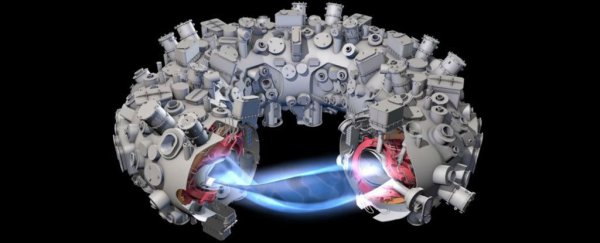German scientists have just switched on the Wendelstein 7-X (W7X) stellarator - the largest nuclear fusion machine of its kind - to successfully produce and sustain hydrogen plasma for the first time.
Why is this such a big deal? The production of hydrogen plasma is key to harnessing the clean, limitless energy of nuclear fusion - the process that powers our Sun. If we can achieve controlled nuclear fusion, it would quite literally change the world, because it would replace fossil fuels and nuclear fission facilities as a cheaper, more efficient, and more sustainable source of energy.
"It's a very clean source of power, the cleanest you could possibly wish for. We're not doing this for us, but for our children and grandchildren," one of the team, physicist John Jelonnek from the Karlsruhe Institute of Technology, told the Associated Press.
Nuclear fission, which is what our current nuclear facilities achieve, generates energy by splitting the nucleus of an atom into smaller neutrons and nuclei. While fission is super efficient - the amount of energy it releases is millions of times more efficient per mass than that of coal - it requires very careful (and costly) management of dangerous radioactive waste.
Nuclear fusion, on the other hand, produces huge amounts of energy when atoms are fused together at incredibly high temperatures - but produces no radioactive waste or other unwanted byproducts.
On top of that, nuclear fusion has been fuelling our Sun for the past 4.5 billion years, which means if we can harness it, humanity is pretty much set for its energy needs for as long as we're in existence. But that's a big "if", because scientists have been working on this for more than six decades now, and are still dealing with some very significant hurdles.
One of the many problems with achieving controlled nuclear fusion is that we actually have to recreate conditions inside the Sun - so, build a machine that's capable of producing and manipulating a 100-million-degree-Celsius (180 million degrees Fahrenheit) ball of plasma gas.
Back in November, researchers at Germany's Max Planck Institute for Plasma Physics switched on their billion-dollar stellerator for the first time, and successfully produced super-hot blobs of helium plasma. This was the first time the stellarator was shown to produce and sustain plasma gas just as well as competing nuclear fusion machines.
Helium was great as a proof of concept, but hydrogen releases a whole lot more energy - it also happens to be a whole lot harder to heat.
But the team reported earlier today that using just 2 megawatts of microwave radiation, they were able to heat hydrogen gas to 80 million degrees for a quarter of a second. This might not sound like much, but again, it's a proof of concept, and the team says they're conceivably able to scale things up to heat the hydrogen gas to that 100 million degree benchmark, and also sustain the resulting plasma for much longer.
"Experiments with hydrogen plasma will continue until March when protective carbon tiles and a divertor for the elimination of impurities will be mounted inside the reactor vessel," Alexander Hellemans reports for Spectrum IEEE. "The microwave plasma heating power will then be increased to 20 megawatts, allowing plasmas to last as long as 30 minutes."
The team says that the W-X stellerator isn't actually designed to produce useable amounts of energy via nuclear fusion - its role is to simply prove that it can be done. "In a later phase of W-X, starting in 2019, we will use deuterium and we will get fusion reactions, but not enough to get more energy out than we are putting in," one of the team, Hans-Stephan Bosch, told Hellemans, adding that there are no plans to add tritium to the hydrogen plasma to break even.
Watch this space, because these are really exciting times, now that the W-X is officially competing with the ITER - a huge nuclear fusion reactor in France that's also managed to trap plasma long enough for fusion to occur. We can't wait to see what happens in March.
